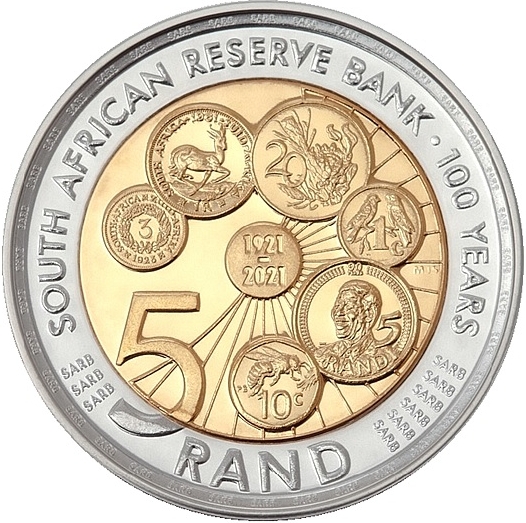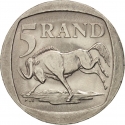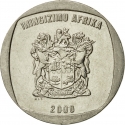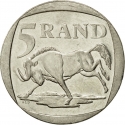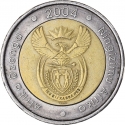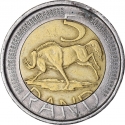You are about to finish your registration. Please check your mailbox (including spam folder). There should be a letter with a confirmation link. Check setting to make sure that your e-mail address is correct.
Send letter againDescription
The South African Reserve Bank has released new five-rand commemorative coins in celebration of the centenary anniversary of the founding of the country’s central bank. The South African Reserve Bank (SARB) was officially founded on the 30th June 1921 with the Currency and Banking Act 31 of 1920 which provided for the establishment of a central bank in South Africa. Its main functions were the issuance of banknotes and coins as well as managing the vast reserves of gold held by commercial banks. The South African Reserve bank is now the oldest central bank in Africa. In May 1961, when the Republic of South Africa was established, it was also the same year South Africa exited the Commonwealth and transitioned its legacy currency from pounds, shillings, and pence to a decimal system of 100 cents in one rand and two rand equalling one pound. The currency has since gone through significant technological and design changes and it is these design changes that capture the significant historical moments of South Africa.
Launched in 1989, the five-rand coin was part of the third series of decimal coins and which replaced the banknote of the same value. In 2004, a bi-metallic version of this denomination with improved security features replaced the nickel-plated steel coins.
Obverse

|
New national coat of arms for South Africa (adopted on 27 April 2000), the country name in Xhosa and in Afrikaans, two of the nine official languages in South Africa. uMzantsi Afrika • 2021 • Suid-Afrika |
|---|---|
Reverse

|
Depicts five coins, depicting the history of the SARB and how South Africa’s currency mirrored the changing economic and political developments as follows: SOUTH AFRICAN RESERVE BANK • 100 YEARS |
| Edge |
Security edge with the initials of the South Africa Reserve Bank and the face value repeated 10 times SARB R5 SARB R5 SARB R5 SARB R5 SARB R5 SARB R5 SARB R5 SARB R5 SARB R5 SARB R5 |
Characteristics
| Type | Commemorative Issue (Circulating) |
| Material | Bi-Metallic |
| Ring | Cupronickel |
| Center | Brass |
| Weight | 9.4 g |
| Diameter | 26 mm |
| Thickness | 3 mm |
| Shape |
|
| Alignment | Medal |
| Mint |
South African Mint (SA Mint)
|

